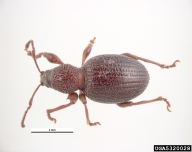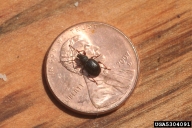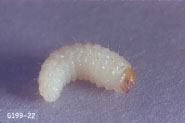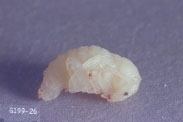Strawberry root weevil
Otiorhynchus ovatus (L.) (Coleoptera: Curculionidae)
Orientation to pest
The strawberry root weevil, Otiorhynchus ovatus (L.), is invasive in North America. It is polyphagous, and larvae feed on plant roots, while adults feed nocturnally on the foliage, buds and young shoots of a wide range of host plants. Adults do not fly and all are females. Unlike white grubs (larvae of scarabs), weevil larvae such as those of strawberry root weevil, are less C-shaped and lack legs. Black vine weevil, Otiorhynchus sulcatus (Fabricius), is a similar appearing species, but whose larvae are much larger than those of strawberry root weevil. In Oregon, strawberry root weevil overwinters as partially grown larvae or as adults. Adults emerge in late May and early June and begin laying eggs about two weeks later. Larvae feed from September through April of the following year and cause the most damage from late March to mid-May. Strawberry root weevil is a forestry pest only in the context of forest nurseries, where infestations may build up. Larvae feed on roots of tree seedlings and can be controlled by soil applications of chemical insecticides, nematodes, or entomopathogenic fungi.
Hosts commonly attacked
Adult beetles feed on foliage, especially of arborvitae (Thuja). The larvae feed on the roots of hemlock (Tsuga) and various other conifers, such as spruce (Picea), pine (Pinus), yew (Taxus), arborvitae, and hemlock, as well as a variety of agricultural crops.
Distribution
The strawberry root weevil is found in most parts of the United States and southern Canada.
Images of strawberry root weevil
| Figure 2. Larva of strawberry root weevil | ||
| Figure 1. Adult of strawberry root weevil, Otiorhynchus ovatus | Figure 3. Pupa of strawberry root weevil | Figure 4. Girdling of bare root spruce seedlings by adults of strawberry root weevil |
Important biological control agents related to this pest species
The only parasitoid known to attack this species in North America is the braconid Triaspis kurtogaster Martin, but that parasitoid's importance in controlling populations of the weevil is unknown. Various entomopathogenic fungi have been found attacking larvae of strawberry root weevil, such as Isaria fumosorosea Wize (Ifr.) (formerly known as Paecilomyces fumosoroseus [Wize] Brown and Smith) and Metarhizium anisopliae (Metchnikoff) Sorokin. Various nematodes also attack larvae of this species, Heterorhabditis bacteriophora Poinar being the species most promising for control. Several species of both fungi and nematodes have been assessed as biopesticides against larvae of strawberry root weevil in various settings, including forest nurseries, cranberry bogs, and potted nursery stock in and around greenhouses. In general, control has been better in potted plants than open fields, and in warmer soils versus cold soils. Cool temperatures (11-14 °C) reduce efficacy of some species of nematodes.
Web links for information on strawberry root weevil
- IPPC Management Fact Sheet | Oregon State University
- Guide to Sampling and Decision Making | IPM for Raspberries | Washington State University | Whatcom County Extension
Compares several species in the genus Otiorhynchus - Overview of Root Weevils | Natural Resources Canada
Discusses root weevils as pests in forest nurseries
Articles
- Nielsen, D. G. 1989. Minimizing Otiorhynchus root weevil impact in conifer nurseries, pp. 71-79. In: Alfaro, R. I. and S. G. Glover (eds.). Proceedings of Conference: Insects affecting reforestation: biology and damage. Forestry Canada, Pacific and Yukon Region, Victoria, British Columbia
- Vainio, A. and H. M. T. Hokkanen. 1993. The potential of entomopathogenic fungi and nematodes against Otiorhynchus ovatus L. and O. dubius Ström (Col., Curculionidae) in the field. Journal of Applied Entomology 115(4): 379-387.
- Berry, R. E., J. Liu, and E. Groth. 1997. Efficacy and persistence of Heterorhabditis marelatus (Rhabditida: Heterorhabditidae) against root weevils (Coleoptera: Curculionidae) in strawberry. Environmental Entomology 26: 465-470.








